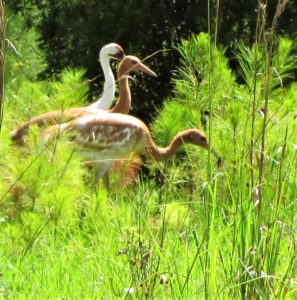White Oak Conservation
Press Release
August 28, 2018 3:38 p.m.
White Oak Conservation and International Crane Foundation move family of 4 to Horicon Wildlife Refuge in Wisconsin

Yulee, Fla. (Aug 28, 2018) — White Oak Conservation is pleased to announce that two young whooping cranes that were hatched this spring at White Oak were reintroduced to the wild this weekend with their mother and father.
The family of four were flown by private jet to Horicon National Wildlife Refuge in eastern Wisconsin, the culmination of a successful breeding program of this critically endangered species, conducted with the International Crane Foundation and the Whooping Crane Eastern Partnership (WCEP).
The young cranes, a male and a female, hatched in late April at White Oak Conservation, a wildlife refuge in northeastern Florida owned by philanthropists Mark and Kimbra Walter. Since then, they have grown nearly as big as their parents and have been taught to fly by their father 16-11, also known as Grasshopper, and their mother 18-12, known as Hemlock.
Photos and videos of the crane family while they were at White Oak are available here.
The young cranes are now able to fly and the whole family has been fitted with VHF and GPS telemetry devices attached to their color bands, which will allow researchers to track their future movements. The family was transported to Wisconsin on a private flight donated by Windway Capital Corporation, which has been donating flights to the ICF and whooping crane recovery program since the early 1980s.
“White Oak’s mission is to save endangered species around the globe, and as this case shows, exceptional care and planning among many partners is required to achieve it,” Mark Walter said. “This month’s events make me hopeful for the future of the whooping crane.”
Grasshopper was raised by the International Crane Foundation in Wisconsin and released at Horicon in 2011. Hemlock also was reared by the International Crane Foundation, but remained at the foundation’s headquarters until both cranes were moved to White Oak in October 2016 and introduced for breeding.
The 4-month-old cranes — 73-18 and 74-18 — are the adult pair’s first offspring. Their hatches were a milestone for the species, as only 700 to 800 whooping cranes remain in North America because of hunting, power line collisions, habitat reduction and encroachment.
At Horicon, the family is first settling into an enclosure in the adult male’s old territory and will be moved into the larger marsh after a short period of acclimation. The adult male will teach the family to survive in the wild, and all four cranes are expected to migrate as a family to their wintering area in the fall. The family likely will stay together until the next breeding season, in spring 2019, when the young cranes will strike out on their own. The adult cranes typically pair for life.
This whooping crane family is part of the Eastern Migratory Population, one of two current experimental release programs that seek to protect the existence of this critically endangered wetland bird. Through decades of dedicated research and captive husbandry, the International Crane Foundation and its partners have rescued the whooping crane from the brink of extinction.
“The successful release of this crane family is testament to the commitment and cooperation of the partners involved, resulting in positive outcomes and support for the long-term recovery of the whooping crane,” said Steve Shurter, CEO of White Oak Conservation.
“Every individual of an endangered species is important, and success stories like this are critical for whooping cranes,” said Anne Lacy, Crane Research Coordinator for the International Crane Foundation. “The pairing of 16-11 and 18-12, their two healthy chicks, and now the family’s return to their breeding grounds in Wisconsin, gives us hope for the future of the species.”
This program is managed and monitored collaboratively by the Whooping Crane Eastern Partnership. Members include the International Crane Foundation, U.S. Fish and Wildlife Service, Patuxent Wildlife Research Center, Operation Migration, the Wisconsin Department of Natural Resources, White Oak Conservation, and other partners.
About White Oak Conservation
White Oak works to save endangered species and wild places. White Oak leads global conservation through innovative science, education, training and collaborations. We are committed to providing conservation options for many of the species that need them the most. White Oak’s 16,000 riverfront acres in northeast Florida provide a refuge for more than 17 different endangered species. Additionally, White Oak works to help and inspire others to support conservation by hosting education, conservation, corporate and family groups for visits, overnight stays, conferences, and meetings. We are an Association of Zoos & Aquariums (AZA) certified facility. White Oak is owned by philanthropists Mark and Kimbra Walter.
About the International Crane Foundation
The International Crane Foundation plays a leading role in the conservation of Whooping Cranes, from managed breeding and release programs to habitat protection, citizen education and engagement, and threat reduction along their flyways. Learn more about the International Crane Foundation and its work to protect Endangered Whooping Cranes at www.savingcranes.org
About the Whooping Crane Eastern Partnership
The Whooping Crane Eastern Partnership is a group of agencies, non-profit organizations and individuals, formed to restore to eastern North America, a migratory population of Whooping Cranes. More information about the partnership is available at www.bringbackthecranes.org
